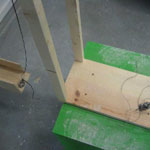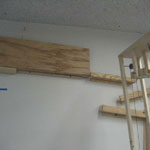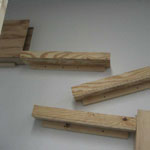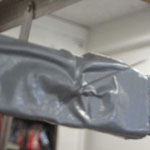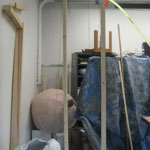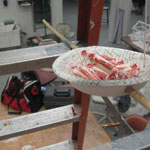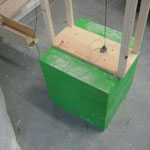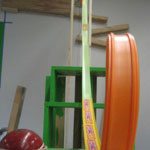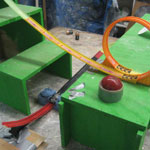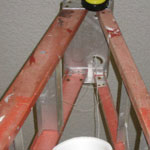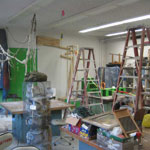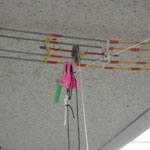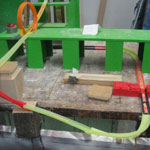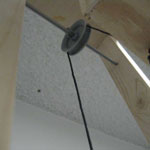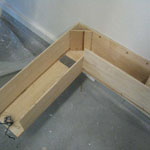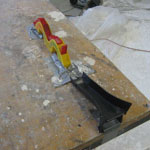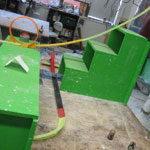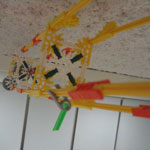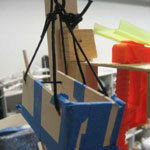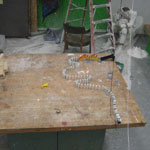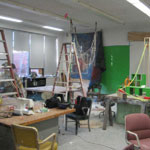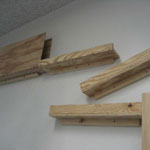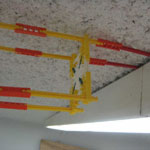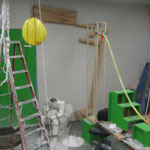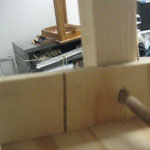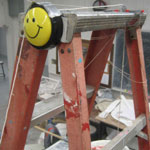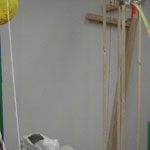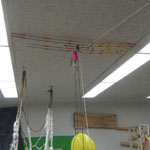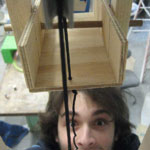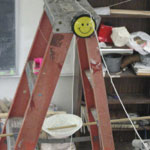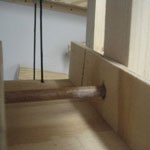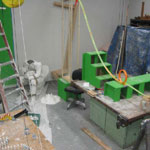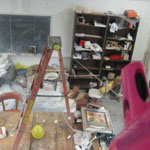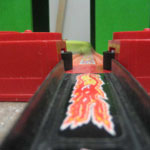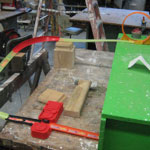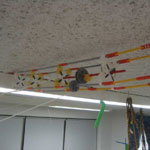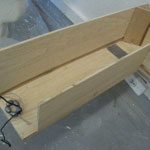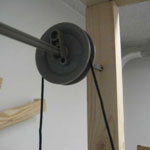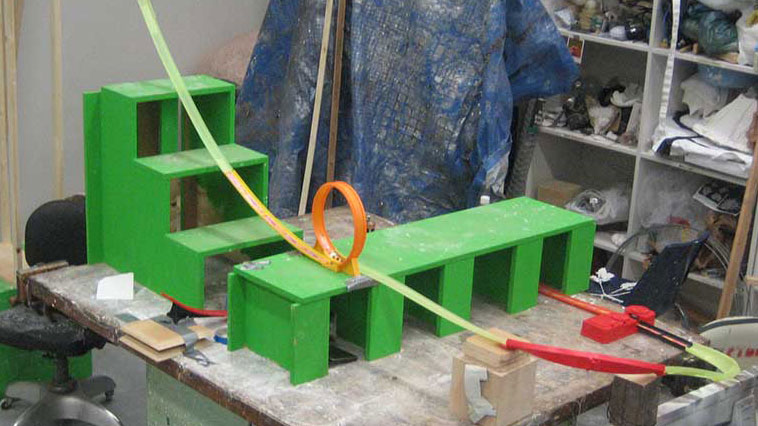
This assignment was to make our “best (sculpture) project ever.” It was the final project for my sculpture class. We were allowed to redo/improve a project we had made earlier in the semester or create something totally new. We were also allowed to partner up if we wanted. I partnered with another student in the class, Chris. We decided to take one of his previous projects and make it a billion-kajillion times better! His previous project was a short Rube Goldberg. How do you make a Rube Goldberg better? Make it longer, more convoluted, and more ridiculous! All of the steps in this Rube Goldberg were designed to accomplish one thing—celebrate the end of the semester by dispensing candy and confetti.
Here is the original description of the piece:
“Grand Finale” is a collaborative project based upon the works done mainly by Rube Goldberg. The definition of a “Rube Goldberg” in the dictionary is “a comically involved, complicated invention, laboriously contrived to perform a simple operation.” “Grand Finale” fits this definition perfectly.
As with any Rube Goldberg, many themes and ideas can be seen in this piece. One such as laziness or inactivity can easily be read –“Who would go through the trouble of creating a device to do such a menial task when, in the time spent building said device, the creator could have, most likely, done the sought after task hundreds of times?” One could argue a theme of genius innovation and technical brilliance –“This is such an amazing machine! How did the creator ever think of this?!” One could even go so far as to declare a comment on the state of human kind –“People rely far too much on machines. Without machines, people wouldn’t be able to do anything!” These are all valid interpretations which connote their own individual views and beliefs upon the piece. Please feel free to decide for yourself what you believe this piece is about.
As one can clearly see by simply looking at the piece, it is a very large and complicated work. The piece is strung together by a series of events which are triggered by preceding events and, in turn, trigger following events.
The first event is that the user pulls a string which causes a door to open inside a large-walled tunnel. The upward removal of this door triggers the first step in this long and marvelous machine. The ball. The ball is the start of it all. As the door is lifted, it allows a croquet ball to gently roll along a slanted tunnel and into a series of three downward-angled ramps; it noisily clanks and clashes to its next destination. The ball then cascades down a long, vertical shaft, and lands at the bottom, thus rolling out of a small hole and onto wooden, bordered paths. When the ball reaches the end of the paths, it furiously hits a set of weights off of its resting place on the edge of the shared path. The falling motion of the weights pulls on a string attached to said weights. This string loops around a wheel device and is put through a wood block via a drilled hole. The weights, in combination with the string and wheel, act as a pulley device which lifts the front of the aforementioned wood block, which, in turn, causes the opposite side of the block to dip down. Another set of weights, resting on the wood block, then slides down the block and allows gravity to do its duty; it falls down which, thanks to another pulley device similar to the first, lifts yet another door. This door, now removed, releases a toy car which, with its barrier eliminated, begins to roll down from its resting place. The car then reels onto a set of precariously, deviously, and quite cleverly placed Hot Wheels tracks. After a stunning display of loops and turns, the car is launched into the air, across a multiple foot gap from one table to another. Depending on the wind of the course, the mood of the gods, and the lunar tides, the car will either make it to the next table and slide to a victorious stop, or the car will ram into the side of the table and fall into a sea of failure. Regardless of our brave heroes end, its job will be done, for you see, this direct contact or indirect vibration will set into motion a path of dominos. The dominos will slip and slope, slump and spill, and of course, tip and tumble their small but dedicated ways across the table in a fascinating array of both glee and tragedy. After the fallen dominos have taken their stand (or lack thereof), they will pitch in one last desperate measure and throw their strongest off of the table. Yes, that’s right, a stack of three dominos. The taped stack of domino warriors will then fall headlong to the ground, rapidly approaching their tragic end. Lucky for our dominos the creators of this piece did not want them to die. In vein. The dominos, while falling, drag down with them an attached string. This string is tied not only to the dominos, but also a high-hanging, smaller string, feet above. This string is quite different from the others used in this glorious display of ingenuity. For this string, you see, acts as a zip line of sorts. A device (which we will thusly name Ricardo, or Bob, or Jacques… or really whatever name feels right for you and your personal pleasures) which has tiny wheels on its inside rides down the path the string lays out for it; merely a child’s plaything, used for something of much, much greater and graver importance. So as the dominos say their final farewells, they pull with them a string which is tied around Ricardo’s life line, if you will. When the tension from the dominos pulls on the butterfly loop tied to Jacques’ string, the loop releases, and allows Alexander to freely fly down his rope of truth and justice. As Stephen glides along his tethered avenue, he gazes upon his companions who have either willingly or unwillingly (we don’t really know) given their lives, their passion, their complete devotion to the cause of a greater good. What brave, brave souls. The task for which they have all strived will soon be complete. As Bob finishes his deed, he rolls to an abrupt stop as he runs into a ladder (onto which the other end of his string has been tied). The exact spot he hits, however, is more than just the side of a ladder (for that would be both anticlimactic and cruel to brave Bob), it is actually a very happy and cheerful light duct taped to the side of the ladder. Our jubilant light comes complete with a warm, loving glow and a smile big enough to span the colossal chasms of the Grand Canyon itself. So with Stephen turning on our cheery light, the observing crowd could not be more satisfied with this classic Rube Goldberg. Unless, of course, there were a balloon filled with confetti tied to Ricardo which would hit a needle taped to the ladder, as Alexander himself hit the ladder, thus causing the balloon to instantaneously pop with a loud bang and release its wondrous treasures (confetti for those who weren’t paying attention) all among the viewers and among various other surrounding objects and/or persons. It couldn’t get any better than this! But what if, just what if, there were a bowl of delicious candy which was also knocked over and scattered onto the floor and table? That would be terrific! Well it’s a good thing there is such an object (we wouldn’t want to disappoint)! And with the fall of the treats, the job is complete. What began with a simple pull of a string started a series of events strung together by levers, pulleys, gravity, knots, and yes, string. In the end, the user bypasses the need to turn on a light and distribute candy him/herself by use of this overly complicated, thoughtfully playful, and very dramatic Rube Goldberg device. And thus ends Chris’ and Adam’s best Sculpture 2701 project ever.





